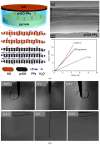Recent Advances on Polypyrrole Electroactuators
- PMID: 30965751
- PMCID: PMC6418990
- DOI: 10.3390/polym9090446
Recent Advances on Polypyrrole Electroactuators
Abstract
Featuring controllable electrochemomechanical deformation and excellent biocompatibility, polypyrrole electroactuators used as artificial muscles play a vital role in the design of biomimetic robots and biomedical devices. In the past decade, tremendous efforts have been devoted to their optimization on electroactivity, electrochemical stability, and actuation speed, thereby gradually filling the gaps between desired capabilities and practical performances. This review summarizes recent advances on polypyrrole electroactuators, with particular emphases on novel counterions and conformation-reinforcing skeletons. Progress and challenges are comparatively demonstrated and critically analyzed, to enlighten future developments of advanced electroactuators based on polypyrrole and other conducting polymers.
Keywords: conducting polymer; counterion; delamination; electroactivity; high-speed.
Conflict of interest statement
The authors declare no conflict of interest.
Figures








References
-
- Tsai H.-K.A., Madou M. Microfabrication of bilayer polymer actuator valves for controlled drug delivery. JALA. 2007;12:291–295. doi: 10.1016/j.jala.2007.06.010. - DOI
-
- Entezami A.A., Massoumi B. Artificial muscles, biosensors and drug delivery systems based on conducting polymers: A review. Iran. Polym. J. 2006;15:13–30.
-
- Spinks G.M., Wallace G.G. Actuated pins for braille displays. In: Carpi F., Smela E., editors. Biomedical Applications of Electroactive Polymer Actuators. Wiley; Hoboken, NJ, USA: 2009. pp. 265–277.
-
- Fang Y., Tan X. A novel diaphragm micropump actuated by conjugated polymer petals: Fabrication, modeling, and experimental results. Sens. Actuators A. 2010;158:121–131. doi: 10.1016/j.sna.2009.12.012. - DOI
Publication types
Grants and funding
LinkOut - more resources
Full Text Sources
Other Literature Sources
Miscellaneous

